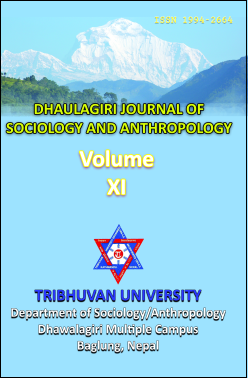Significant Heritages of Upper Mustang and Issue of Conservation
DOI:
https://doi.org/10.3126/dsaj.v11i0.18820Keywords:
Archaeological caves, petroglyph, heritages, saligram (Ammonite), anthropomorphic figureAbstract
Upper Mustang has been an important centre of Tibetan Buddhism for many centuries. The walled city of Lomanthang with three monasteries Jyampa, Thubchen and Chodye, Chortens and mani wall, the monasteries of Namgyal, Loghekar, Charang, Ghami and Ghiling, the palaces of Lomanthang and Charang, the Chungsi, Gonga Gang and Luri caves, the 305-metre long Mani wall and Khorok chortens in Ghami, and the group of chörtens in Tangya are the outstanding tangible monuments of Upper Mustang, which are collectively significant because of their paintings, sculptures, manuscripts and other artefacts, and also because of their intangible heritage. Upper Lo Mustang is famous for its hundreds of caves. It’s famous river Kaligandaki, is the only river in Nepal where śāligrāmas, stones containing ammonites, are found. These black stones are very sacred to both Buddhists and Hindus. Upper Mustang is the most promising area in Nepal for archaeological work. It is rich in both indigenous biodiversity and cultural heritage. The main purpose of this article is to light on how important is the Mustang in aspect of archaeological and heritages, it also focus on how new built road would impact its heritages.
Dhaulagiri Journal of Sociology and Anthropology Vol.11, 2017; 1-23




